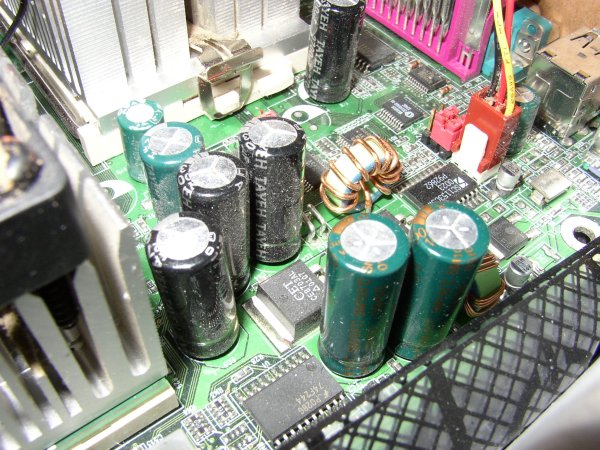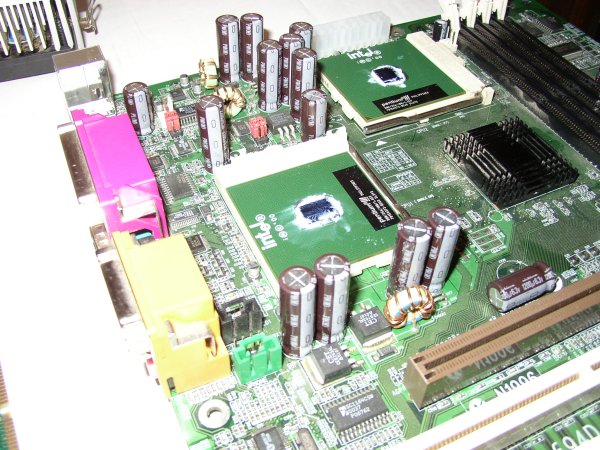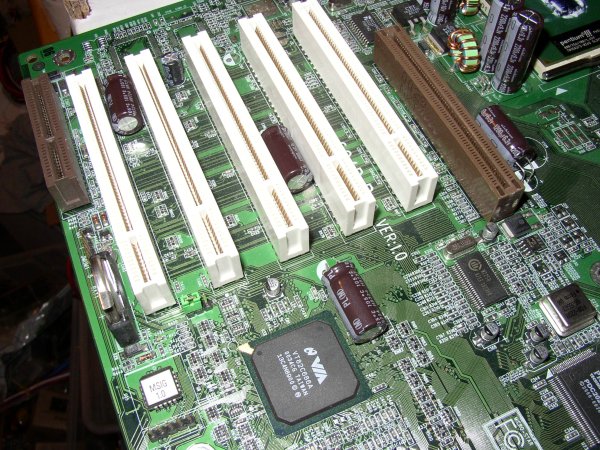Board history:
Bought off ebay for $30, free shipping. Seller claimed worked great. Arrives, and of course half the caps have domed tops, only POSTs about half the time with one cpu, and won't even init video with two cpus.
Caps:
6 Tayeh 2700 @ 6.3v. All buldging. Replaced with nichicon 2200 @ 6.3v PM series.
1 Tayeh 1500 @ 6.3v. Looked OK. Replaced with same as above.
4 Teapo 1500 @ 10v. Looked OK, but teapos tend to fail with no physical signs. Replaced with nichicon 1500 @ 10v PM series.
8 Chhsi 1000 @ 6.3v. Half were domed. Replaced with nichicon 1200uf @ 6.3v PL series.
3 Chhsi 470 @ 16v. Looked ok, but were large and had vents, so decided to replace even though they were under 1000uf. Quick check with DMM showed they only had 5v on them. Replaced with same as above.
Total 22 caps replaced.
Replacing:
Replacement was reasonably easy, with only a few of the 8mm ones being a pain to remove. Desoldering station died on the very last lead. Did last lead by pulling the cap out and cleaning with a hot needle. Will need to fix desoldering station before next board...
The four caps near the expansion slots were all installed on their sides, to prevent interference with any cards I might put in. The replacements were quite a bit larger than the originals, and I could easily see them hitting a heat sink or the like...
Why I'm in a bad mood:
After recapping, board posted perfectly with my testing cpu. Went to remove it to put in the real cpus, and noticed one missing smt cap and one damaged one next to the cpu1 socket. Was able to resolder the damaged one, but the other is lost for good. It looks like it's only a power supply bypass cap (in fact, it's in parallel with the new caps I just put in), and the board seems to work fine without it, but it still pisses me off. I checked the pics I took when I first got the board, and they're missing there too... so at least I didn't do it. still pissed off though.
Board-specific notes:
C390 is indeed backwards. Measured it with my DMM, and it has -3.3 volts on it. My other 694d has this cap installed backwards. Installed the new C390 backwards.
The 470uf 16v caps were Chhsi, one of the most failure-prone brands I've seen. They were also pretty large, and had top vents. I decided to replace them as a precaution. A quick DMM check showed they all had 5v on them (and from the board they looked like bypass caps), so just replaced them with the same 1200 @ 6.3 caps I used elsewhere.
Before pics:

The tops of the black Tayeh ones are domed, even though it's not clear in the photo.

Domed tops on the small chhsi caps.

Damaged and missing SMT caps, visible in one of the "before" photos. Also another two slightly buldging tayeh caps and a buldging chssi cap.
After pics:

Overview of the board. Yes, all 22 are visible. Mmmm, shiny!

CPU-area capacitor clusters. Also shiny.

Sideways caps... They'd stick up unacceptably if I put them in normally.
Current results:
Seems to work. POSTs perfectly and reliably with both CPUs in, and voltages appear solid. Haven't done any endurance testing yet though... that will wait until I put it in a box and set it on my desk.
Now I need to fix my desoldering station... have another of these boards to do! Somehow the iron part has clogged internally, so it can't suck... probably will have to clear it with my drill.
--Randy
Bought off ebay for $30, free shipping. Seller claimed worked great. Arrives, and of course half the caps have domed tops, only POSTs about half the time with one cpu, and won't even init video with two cpus.
Caps:
6 Tayeh 2700 @ 6.3v. All buldging. Replaced with nichicon 2200 @ 6.3v PM series.
1 Tayeh 1500 @ 6.3v. Looked OK. Replaced with same as above.
4 Teapo 1500 @ 10v. Looked OK, but teapos tend to fail with no physical signs. Replaced with nichicon 1500 @ 10v PM series.
8 Chhsi 1000 @ 6.3v. Half were domed. Replaced with nichicon 1200uf @ 6.3v PL series.
3 Chhsi 470 @ 16v. Looked ok, but were large and had vents, so decided to replace even though they were under 1000uf. Quick check with DMM showed they only had 5v on them. Replaced with same as above.
Total 22 caps replaced.
Replacing:
Replacement was reasonably easy, with only a few of the 8mm ones being a pain to remove. Desoldering station died on the very last lead. Did last lead by pulling the cap out and cleaning with a hot needle. Will need to fix desoldering station before next board...
The four caps near the expansion slots were all installed on their sides, to prevent interference with any cards I might put in. The replacements were quite a bit larger than the originals, and I could easily see them hitting a heat sink or the like...
Why I'm in a bad mood:
After recapping, board posted perfectly with my testing cpu. Went to remove it to put in the real cpus, and noticed one missing smt cap and one damaged one next to the cpu1 socket. Was able to resolder the damaged one, but the other is lost for good. It looks like it's only a power supply bypass cap (in fact, it's in parallel with the new caps I just put in), and the board seems to work fine without it, but it still pisses me off. I checked the pics I took when I first got the board, and they're missing there too... so at least I didn't do it. still pissed off though.
Board-specific notes:
C390 is indeed backwards. Measured it with my DMM, and it has -3.3 volts on it. My other 694d has this cap installed backwards. Installed the new C390 backwards.
The 470uf 16v caps were Chhsi, one of the most failure-prone brands I've seen. They were also pretty large, and had top vents. I decided to replace them as a precaution. A quick DMM check showed they all had 5v on them (and from the board they looked like bypass caps), so just replaced them with the same 1200 @ 6.3 caps I used elsewhere.
Before pics:

The tops of the black Tayeh ones are domed, even though it's not clear in the photo.

Domed tops on the small chhsi caps.

Damaged and missing SMT caps, visible in one of the "before" photos. Also another two slightly buldging tayeh caps and a buldging chssi cap.
After pics:

Overview of the board. Yes, all 22 are visible. Mmmm, shiny!

CPU-area capacitor clusters. Also shiny.

Sideways caps... They'd stick up unacceptably if I put them in normally.
Current results:
Seems to work. POSTs perfectly and reliably with both CPUs in, and voltages appear solid. Haven't done any endurance testing yet though... that will wait until I put it in a box and set it on my desk.
Now I need to fix my desoldering station... have another of these boards to do! Somehow the iron part has clogged internally, so it can't suck... probably will have to clear it with my drill.
--Randy
Comment